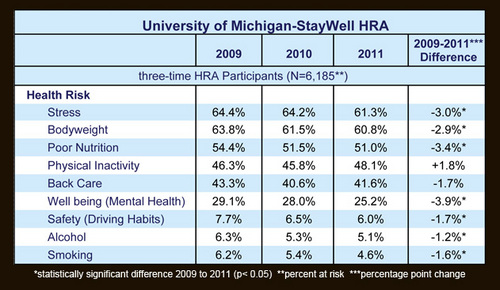Editor's note: This story was edited to clarify the funding mechanism for the rewards program.
For the fifth year in a row, the University of Michigan will be giving $100 to each of its employees enrolled in its health care benefits who participate in online wellness programs -- a measure U-M says has proven to be worthwhile thus far.
The requirements to receive the incentives this year are two fold and each worth $50: Employees must complete a 20-minute online survey on their health, and participate in another eligible activity. The incentives top at $100 pre-taxes and are included in an employee's paycheck.
U-M did a three-year internal evaluation of the program’s success after 2011, and reported that faculty and staff participating in the incentives program had lower health care costs, on average, and a lower rate of absenteeism at work by a small margin.

Changes in Health Risk Assessment factors self-reported by University of Michigan employees.
Courtesy U-M
Employees with high cholesterol or high blood pressure screened in both 2009 and 2012 checkpoints had reductions in their levels, Schmidt said.
Three-year participants averaged $3,922 in annual health care costs from 2008-2010, and non-participants averaged $4,480, according to data provided by U-M.
Wellness programs tend to attract individuals that are already conscious about their weight and health, said Marianne Udow-Phillips, director of the Center for Healthcare Research & Transformation.
The center is a partnership between U-M and Blue Cross Blue Shield of Michigan.
Udow-Phillips said research on the effectiveness of wellness programs has many gaps.
“We really don’t have good research to tell us whether wellness programs work to save money,” Udow-Phillips said. “There is some indication that employees like them, and that there may be some impact on productivity.”
Employers like the concept of wellness programs and they make “intuitive sense” when considering the health and well-being of employees, Udow-Phillips said.
Some research suggests that employees do use online wellness programs if an incentive is provided, Udow-Phillips said, noting the incentive has to be a dollar value high enough to pique interest.
“There’s no research to suggest that long-term cost savings are a result,” Udow-Phillips said. “You end up spending a lot on incentives to engage people and it’s just not clear that it attracts the people that wouldn’t otherwise be engaged with their health.”
About 38,000 employees are benefit-eligible and enrolled in a health care program, as well as 14,000 spouses and other qualified adults. Participation in the wellness programs has varied at about 50 percent of their benefit eligible employees, Schmidt said.
The wellness incentives programs are a benefit paid to its employees by U-M.
“Part of the challenge with these kinds of programs is it takes a little bit of time to see if it has an impact,” Udow-Phillips said.
U-M began its rewards program in 2009, and has offered $100 each year to benefits-eligible employees for completing varying requirements ever since:
- 2009: $50 for completing a questionnaire, $50 for a health screening
- 2010: $50 for completing a questionnaire, $50 for completing two eligible activities
- 2011: $50 for completing a questionnaire, $50 for completing one eligible activity
- 2012: $50 for completing a questionnaire, $50 for a health screening
- 2013: $50 for completing a questionnaire, $50 for completing one eligible activity
“We’re working on different strategies to help get people involved and develop action plans to reach those goals,” Schmidt said.
Eligible activities include an online challenge program called Active U, in which about 10,000 employees participated last year.
The 12-week program has employees set goals and log their physical activity through an online portal, and sends reminder emails with healthy living tips each week. The program also gives prize offerings to participants and a free T-shirt at the end.
U-M is attempting to reach a cumulative goal of 30 million minutes of physical activity for all of its employees this year.
The program is in its eighth year. Enrollment is between Jan. 22 and Feb. 5.
Other eligible activities include individual and group stress management programs, Weight Watchers and MHealthy Weight Management programs, nutrition consultations, personalized exercise sessions, department-level nutrition and physical activities, online educational programs and tobacco treatment programs.
For the first time, U-M has extended the rewards program this year to spouses and other qualified adults covered by U-M health care plans: If they take the health questionnaire, they’ll be entered into a drawing for $500.
Amy Biolchini covers Washtenaw County, health and environmental issues for AnnArbor.com. Reach her at (734) 623-2552, amybiolchini@annarbor.com or on Twitter.